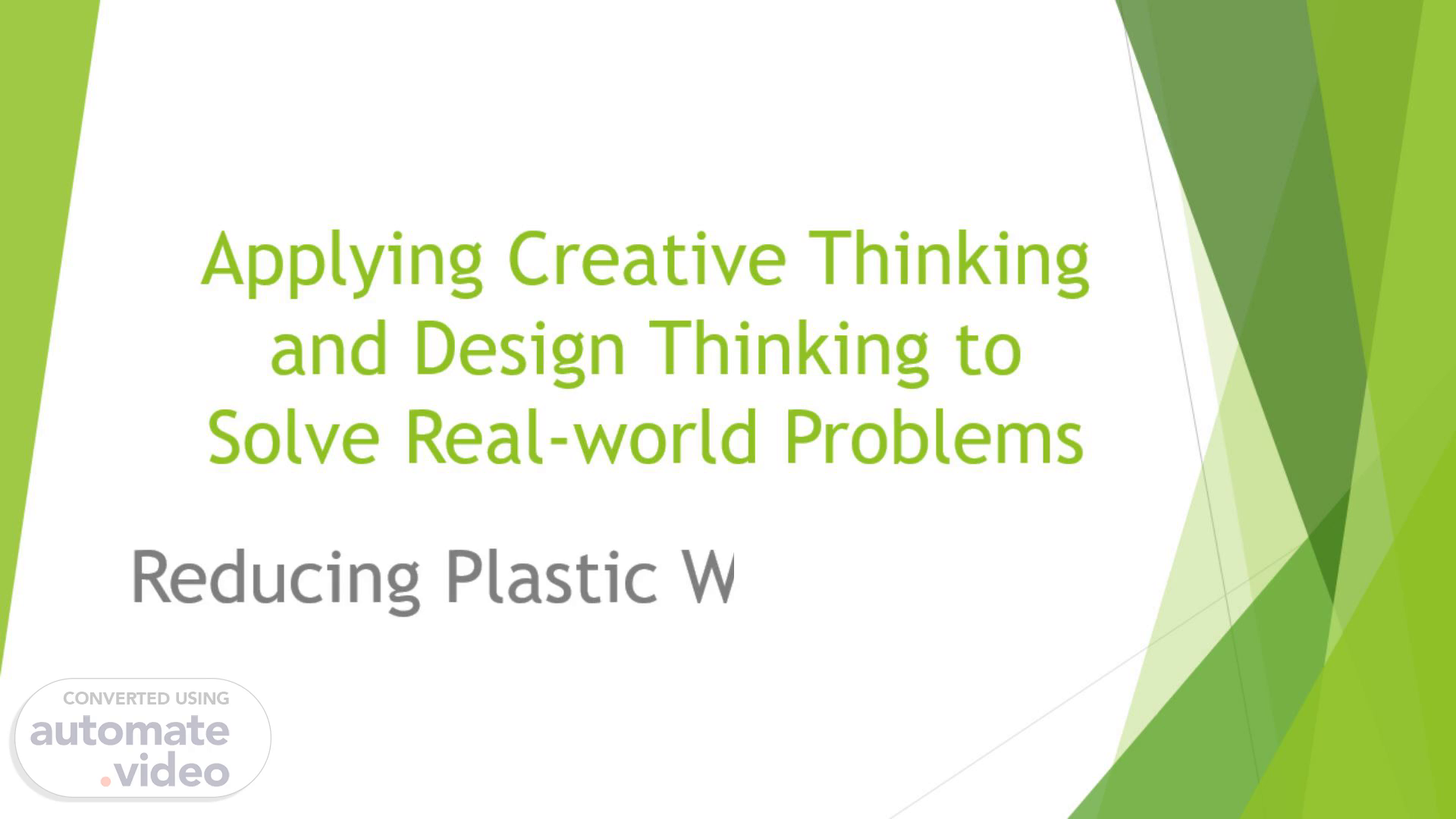
Applying Creative Thinking and Design Thinking to Solve Real-world Problems
Scene 1 (0s)
Applying Creative Thinking and Design Thinking to Solve Real-world Problems.
Scene 2 (8s)
Introduction. Design Thinking is a human-centered approach to problem solving. It combines creativity, critical analysis, and empathy. Goal: Create practical and sustainable solutions for real-life problems. Example problem : Excessive plastic waste generated in schools..
Scene 3 (22s)
Understanding the Problem. Students and teachers often use plastic bottles, cups, and wrappers daily . Plastic waste ends up in bins and is not recycled properly . Challenge: How can we reduce or replace plastic usage inside schools?.
Scene 4 (36s)
Q1.What is Creative Thinking Process?.
Scene 5 (43s)
Creative Thinking is the ability to think differently and generate innovative ideas . It involves imagination, curiosity, and flexibility in finding new solutions . In our case, it means thinking beyond “just avoiding plastic.”.
Scene 6 (56s)
The Creative Thinking Process. 1. Preparation: Research causes of plastic waste and existing eco alternatives .Observe how plastic is used in the school canteen and classrooms. 2. Incubation: Take a break — let the mind explore ideas subconsciously. 3. Illumination: The “aha!” moment: introducing reusable stainless steel bottles and biodegradable lunch boxes..
Scene 7 (1m 14s)
4. Evaluation : Check cost, availability, and acceptance among students. 5. Implementation : Start a “Plastic-Free Week” campaign and provide incentives..
Scene 8 (1m 24s)
Q2. How Can You Describe the Process of Problem Solving with Examples?.
Scene 9 (1m 32s)
Problem Solving Process. 1. Identify the Problem : Plastic waste accumulation in school. 2. Analyze the Problem : Survey where and how plastic is used (canteen, water bottles, packaging). 3. Generate Possible Solutions: Biodegradable materials, refill stations, awareness campaigns..
Scene 10 (1m 48s)
4. Choose the Best Solution : Set up a refillable water station and ban single-use bottles. 5. Implement the Solution : Install water stations, provide metal bottles, conduct awareness drives. 6. Evaluate Results : Measure reduction in plastic waste after one month..
Scene 11 (2m 3s)
Example Outcome. Plastic bottle waste reduced by 60% in the first month. Students adapted easily to reusable bottles. School cafeteria switched to paper and metal alternatives..
Scene 12 (2m 14s)
Q3. How Creative Thinking Process Helps in Problem Solving?.
Scene 13 (2m 22s)
Importance of Creativity in Problem Solving. Encourages out-of-the-box ideas beyond traditional recycling. Promotes collaboration — involving teachers, students, and suppliers. Builds empathy — understanding student convenience and habits . Results in innovative, long-term solutions..
Scene 14 (2m 36s)
Example of Creative Impact. Instead of just banning plastics, the idea evolved into a “Refill and Reward” system. Students who use refillable bottles earn points redeemable in the canteen . Creativity helped make the solution fun, engaging, and sustainable..
Scene 15 (2m 50s)
Q4. How to Test the Efficacy of Creative Problem-Solving Process?.
Scene 16 (2m 57s)
Ways to Test Effectiveness. 1. Prototype Testing: Test refill stations with a small group of students first. 2. Feedback Collection: Conduct surveys for ease of use and satisfaction. 3. Measure Results : Compare plastic waste volume before and after implementation. 4. Iterate and Improve : Add more refill points or redesign bottle types based on feedback..
Scene 17 (3m 16s)
Conclusion. Creative thinking transforms challenges into opportunities. The process of research, ideation, testing, and evaluation ensures real impact. With design thinking, we create solutions that are practical, human-centered, and innovative . In our example, a creative approach led to a cleaner, greener school..